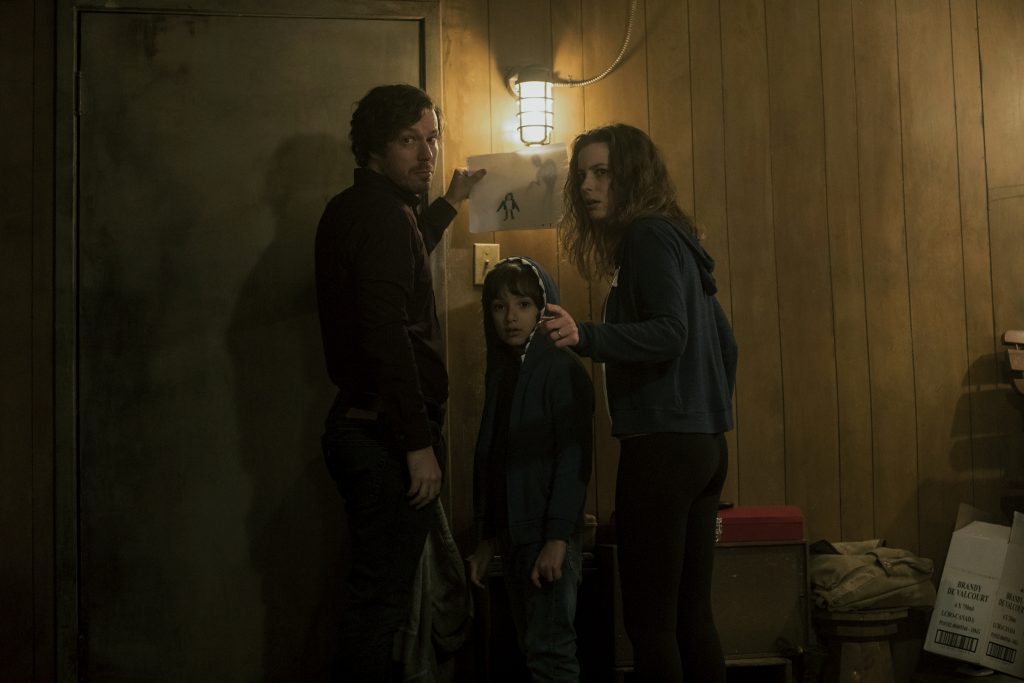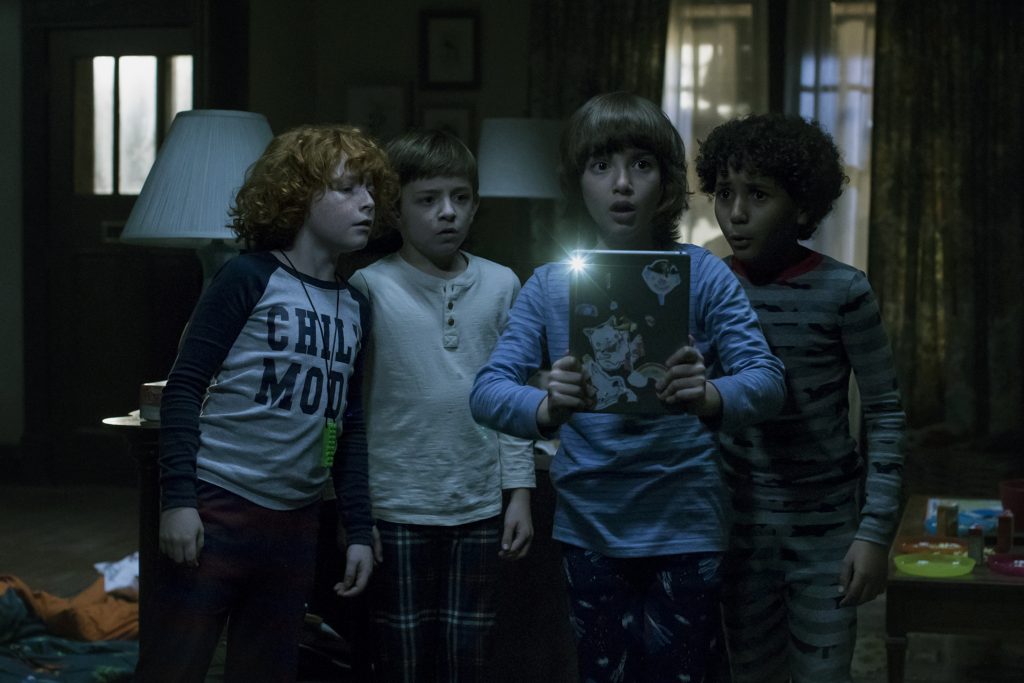Azhy Robertson, Come Play, Gavin MacIver-Wright, Gillian Jacobs, horror, Jacob Chase, Jaden Marine, movies, Rachel Wilson, reviews, Winslow Fegley
October 30, 2020
by Carla Hay

Directed by Jacob Chase
Culture Representation: Taking place in an unnamed U.S. city, the horror film “Come Play” has a predominantly white cast (with some African Americans) representing the middle-class.
Culture Clash: A mute autistic boy comes across a mysterious computer app where a sinister creature named Larry wants to make a human friend.
Culture Audience: “Come Play” will appeal primarily to people who like horror movies that have a simple story, good visual effects and scares that aren’t very bloody or gruesome, but other viewers might be easily bored by the repetitive nature of this story.

“Come Play” is the type of horror movie that would have been better off as a short film. Although “Come Play” benefits from better-than-average performances from the movie’s main actors, and the final third of the film is the most impactful, the movie’s concept ultimately stretches too thin for a feature-length film. There are too many long sections of the movie that become repetitive and dull before the climactic “showdown” scene. “Come Play” will also draw inevitable comparisons to writer/director Jennifer Kent’s far-superior 2014 horror film “The Babadook,” a movie that’s also about a sinister creature that lives in the pages of a children’s story, and the creature can transport itself into the world when people read the story.
Written and directed by Jacob Chase, “Come Play” (which is based on Chase’s short film “Larry”) demonstrates that he has a good eye for creating the right spooky atmosphere in the right places. The casting for this movie is also well-done. However, the first two-thirds of the film are essentially a repeat loop of a mute kid trying to convince his parents that an evil monster lives in a spooky story app that keeps showing up mysteriously on his computer tablet and phone. His frustration over not being believed becomes tedious to watch after a while, because it doesn’t progress the story until one of his parents start to believe him more than the other parent.
The 8-year-old child at the center of the story is Oliver (played by Azhy Robertson, in a terrific performance), who is autistic and mute. Oliver communicates through a talking computer device that can say the words that he selects. Oliver’s autism has not prevented him from going to a regular public school, but in the beginning of the movie, it’s shown that he is an outcast and a loner at school.
Oliver’s well-meaning parents are Sarah (played by Gillian Jacobs) and Marty (played by John Gallagher Jr.), who end up separating during this story. Their separation had already been decided before this story took place, and there are hints that Marty is going to be the one who moves out of the house. In the opening scene, Marty is sleeping on the couch, while Sarah is sleeping alone in their bedroom. And there are some packed boxes in the living room, as if he’s already started his move out of the home.
Oliver doesn’t know yet that his parents have decided to split up when he first encounters the creepy monster named Larry. The creature is a skeletal, hunched-over figure that Oliver first sees as an illustration in a children’s story app called “Misunderstood Monsters” that shows up on his computer tablet one night when he’s lying awake in bed. As Oliver swipes through the pages of this story, he sees these words: “This is Larry. Larry never gets to play pretend. He gets made fun of because he’s different. Larry just wants a friend.”
When Oliver gets to another page screen on the tablet, the lights suddenly go off in his room and in the hallway outside of his room. And then he hears the sound of dragging footsteps that get closer and closer, until he screams. And then, Oliver’s mother Sarah comes in the room and tells Oliver that he must have had a nightmare.
The pattern happens every time someone looks at the “Misunderstood Monsters” app and reads Larry’s story. The only variations are when Larry “appears” or seems to appear, Larry sometimes does something a little different. Larry might be crouched in a corner of the living room or kitchen. Larry might be lurking in a hallway. Eventually, it’s revealed that when any computer device with the Larry story is aimed right at Larry, the creature can only be seen on the device’s camera.
When the Larry creature is shown in its full-body entirety, the visuals effects are fairly good, but not uniquely impressive enough, considering that the “skeleton man” archetype has been used before in many other horror movies. But since “Come Play” isn’t a gory horror movie, Larry doesn’t seem to be a vicious murderer. If he does want someone to play with, how is that going to happen?
Even if Oliver tries to stop using his computer tablet and hides it, Larry has a way of coming back into Oliver’s life. Marty works the late shift as a security guard in an outdoor parking lot. For whatever reason, in one of those “only in a movie” coincidences, Marty sees a computer tablet that was in the lost-and-found bin at his work station. This tablet has the Larry story on it, and Marty starts reading it while he’s on the job. Several lights in the parking lot suddenly go out. And then, cars in the parking lot start blink their lights or mysteriously revving their engines.
Marty thinks it’s a freak electricity malfunction, but viewers of “Come Play” know better. Marty brings home the computer tablet and gives the tablet to Oliver as a replacement for the one that Byron threw away in the field. And with that, Larry is back in the family home and back in Oliver’s life.
The plot of “Come Play” is a little too flimsy to be sustained with these mild scares. It’s not a spoiler to reveal that the movie never really explains why Larry has targeted this family, although viewers can assume that Oliver’s “outcast” loneliness might have been what attracted Larry. At one point in the story, Larry tells Oliver through computer language: “Your parents want you to be normal. I just want to be your friend.” Oliver is the first one in the family to see Larry, but eventually, Oliver’s not the only one.
Even though there are some Larry moments that are genuinely creepy, there’s absolutely no context of how Larry came into existence and how long Larry has possibly existed. The simple plot of this movie really is that a monster comes after a boy, who has a hard time convincing his parents and everyone around him that what he’s experiencing is real. The adults predictably think that Oliver just has an active imagination.
And then there’s the cliché horror subplot of a bully who gets a comeuppance. Oliver is bullied by a brat named Byron (played by Winslow Fegley), who is in the same class as Oliver at school. One day, Byron and two of his cronies—Zach (played by Gavin MacIver-Wright) and Mateo (played by Jaden Marine)—lure Oliver into a deserted field. After some taunting and roughing up of Oliver, who calls Byron “ugly” in response, Byron gets so angry that he takes Oliver’s talking device and throws it so far into the field that Oliver can’t find it.
Why does Byron seem to hate Oliver so much? It turns out that Byron and Oliver used to be best friends, but they had a falling out, and Byron still has a lot of resentment over it. Bryon’s mother Jennifer (played by Rachel Wilson) was also a close friend of Sarah’s, but when their sons stopped being friends, Jennifer and Sarah grew distant from each other too. The details of these estrangements are revealed later in the film, because it’s the catalyst for the story’s more sentimental emotional moments.
After the bullying incident in the field, Sarah decides the best way to end the bullying is to try to get Byron to become friends with Oliver again. Sarah invites Byron to come to their house for a sleepover with Oliver, but Byron will only accept the invitation if he can bring Zach and Mateo with him. It’s during this sleepover that Byron, Mateo and Zach find out about Larry the monster.
Sarah isn’t just trying to repair Oliver’s relationship with Byron. She’s trying to improve her relationship with Oliver. As a homemaker, Sarah spends more time with Oliver than Marty does, and that becomes even more so after Marty moves out of the house. Sarah is the one who accompanies Oliver to his speech therapy sessions, while Marty makes excuses not to go or he has work commitments that prevent him from being there.
Sarah is also the parent who’s more of a disciplinarian, while Marty tends to be more lenient with Oliver. Therefore, Sarah thinks Oliver loves her less than he loves Marty because she’s not the “fun” parent. It’s caused some long-simmering resentment that Sarah has toward Marty, although it’s unclear how much this resentment has caused their marriage to deteriorate. In fact, it’s never really explained why Sarah and Marty broke up, but apparently, the breakup was a long time coming.
It’s an example of how parts of this story are too vague and why this movie would’ve worked better as a short film. A feature-length film can and should have time for more context so viewers can have better insight into the characters’ personalities. Jacobs and Gallagher are very good in their roles, but their characters are just a little too generic for this story.
As for Robertson, he’s by far the best aspect of this movie. Because Oliver is mute, Robertson has to do a lot of acting with his wonderfully expressive face. And even though his character doesn’t use his mouth to talk, Robertson is still able to convey a lot of emotions that will endear people to Oliver. It’s refreshing to see an autistic character portrayed in a way that is poignant yet not exploitative.
Unfortunately, by the time the action really heats up by the end of the film, it’s somewhat diluted when Sarah and Oliver are hiding under a bed and are supposed to be quiet, but then Sarah uses that moment to have a whispered heart-to-heart talk with Oliver. It doesn’t make sense to drop this conversation in the moment where they’re supposed to be the most silent. Even though “Come Play” has a touching message about the strength of a mother’s love, that message is not enough to overcome all the time that’s wasted where not much happens in the movie except a slightly varied rehash of several other scenes.
Focus Features released “Come Play” in U.S. cinemas in October 30, 2020.
